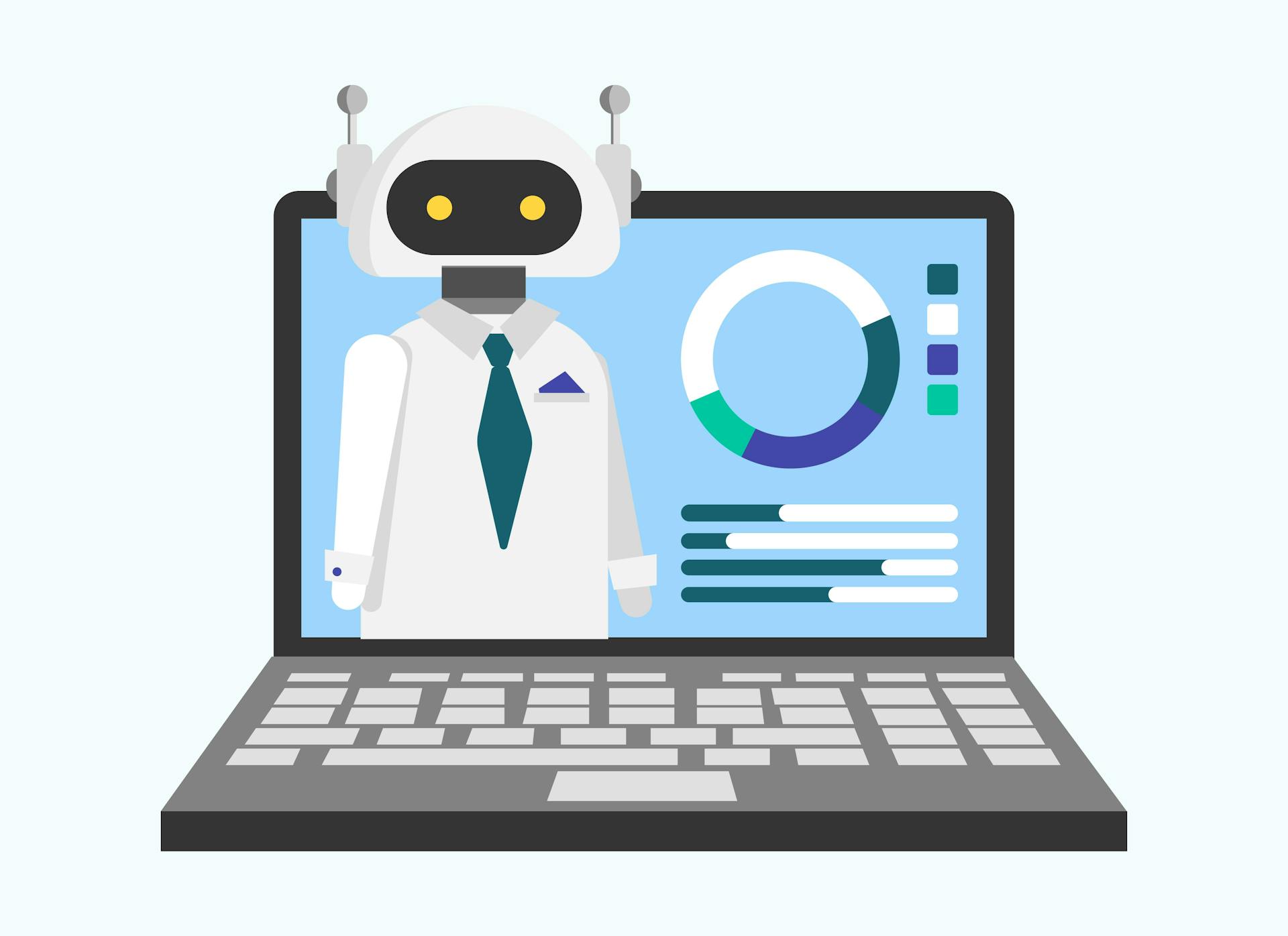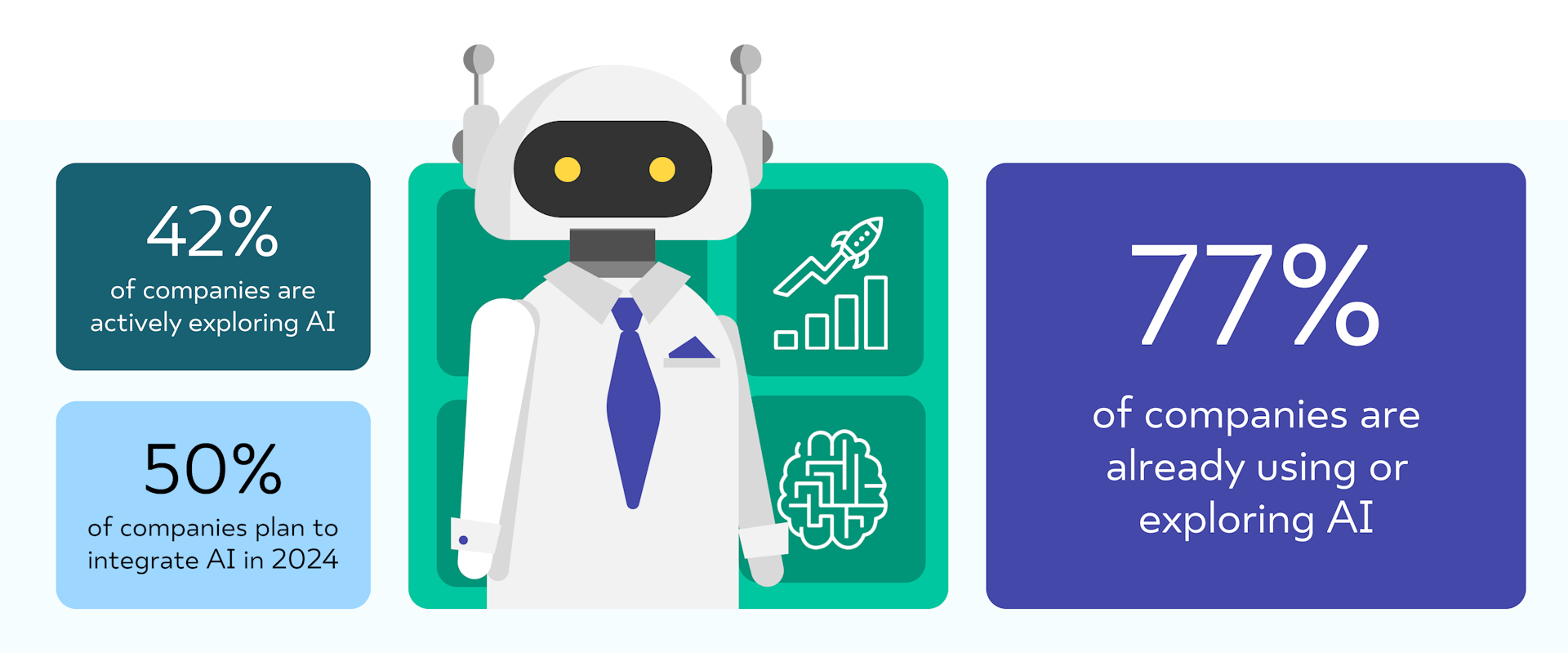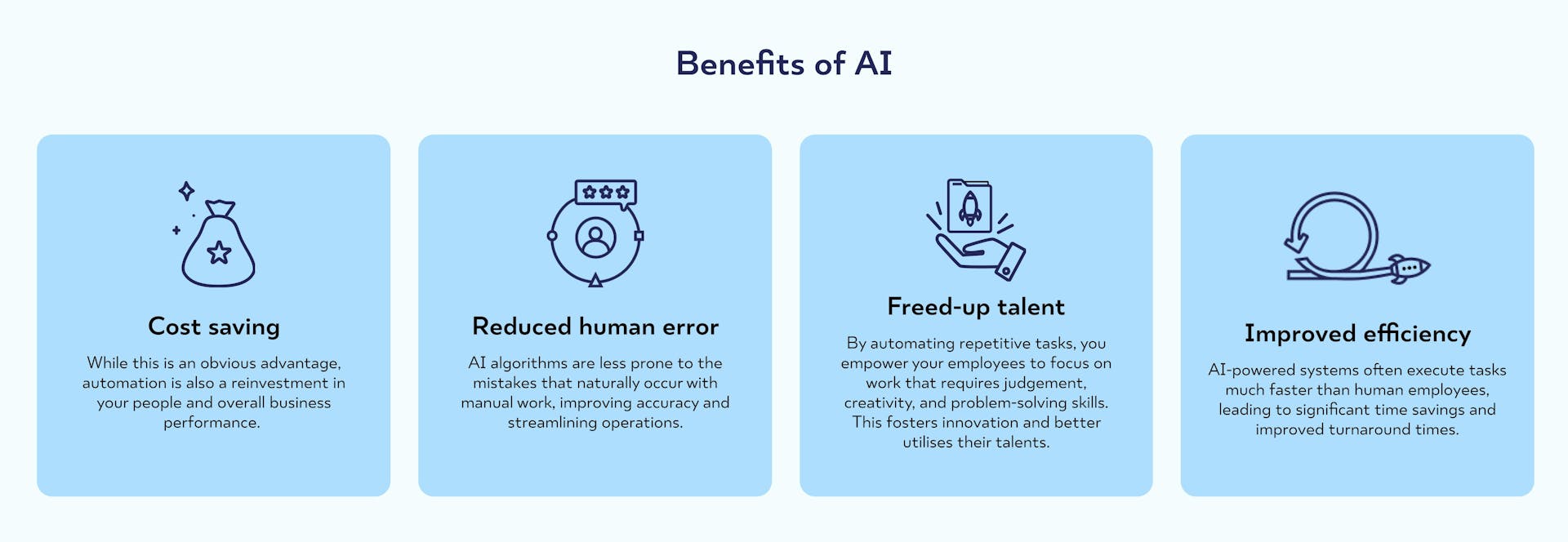AI In Business Examples: Your Guide To Getting Started In 2024

Sure, you've heard about ChatGPT, seen impressive AI-generated art, and maybe even dabbled in AI tools yourself. The hype is real, but you might find yourself asking, "How does all this translate into value for my business?"
The truth is, AI isn't just about flashy demos or a virtual assistant for business management. It's about tangible gains: improved efficiency, smarter decisions, and a competitive edge.
AI adoption is rapidly accelerating. Notably, 42% of companies report actively exploring AI use, and over 50% plan to integrate AI technologies in 2024.
This means a staggering 77% of companies are either already using AI or are in the process of exploring it.

But the time for exploration is over. The AI-powered transformation is happening now, and forward-thinking companies must understand how this technology can directly benefit their organisations and become a long-term strategic priority.
In this article, we’ll guide you through the applications of AI in business and show you how to successfully implement AI within your organisation.
The Basics of Artificial Intelligence in Business
The meteoric rise of large language models (LLMs) like ChatGPT in late 2022 has put AI in the spotlight.
However, it's important to understand that artificial intelligence technology encompasses a broader range of technologies, each offering distinct business value.
Let's break down some essential terms:

AI in Business Examples
Now that you're equipped with the essential AI vocabulary, it's time to shift our focus from 'what' to 'how'. Let's look at examples of artificial intelligence in business.
Process automation to unlock efficiency
Many routine tasks are ripe for AI-driven automation.
AI can excel at repetitive, rules-based business processes like data entry, invoice processing, and even handling basic customer service requests across various areas of your business.
When it comes to automation, the first clear benefit is cost savings.
While this is an obvious advantage, automation is also a reinvestment in your people and overall business performance.

Here are the benefits beyond cost savings:
✔️ Reduced human error: AI algorithms are less prone to the mistakes that naturally occur with manual work, improving accuracy and streamlining operations.
✔️ Freed-up talent: By automating repetitive tasks, you empower your employees to focus on work that requires judgment, creativity, and problem-solving skills. This fosters innovation and better utilises their talents.
✔️ Improved efficiency: AI-powered systems often execute tasks much faster than human employees, leading to significant time savings and improved turnaround times.
Example
Robotic process automation (RPA)
RPA involves software "bots" that mimic human employees' actions within existing systems.
These bots excel at tasks involving transferring data between systems, updating spreadsheets, and generating reports by following a set workflow.
RPA can be used across a wide range of industries, including:
➡️ Finance and accounting: Invoice processing, account reconciliation and financial reporting.
➡️ Human resources (HR): Payroll updates, benefits administration and employee record management.
➡️ Supply chain: Inventory tracking, order processing and updating logistics systems.
➡️ Customer service: Handling routine inquiries and gathering data for agents.
➡️ Compliance: Analysing data to ensure adherence to regulations and reduce the risk of fines or penalties.

“Process automation is not about eliminating jobs; it's about enabling your workforce to contribute to higher-value, strategic aspects of your business.”
Data-Driven Insights
59% of executives are convinced that AI applications will enhance their ability to process big data in their companies. We’re inclined to agree.
Your business generates massive amounts of data collected – sales figures, customer data, market trends, etc.
AI's ability to analyse data at a scale no human can match extracts valuable insights often hidden from view.
Here is how AI-powered data analysis can improve your business functions:
➡️ Informed decision-making: AI uncovers patterns and correlations that support data-driven choices across all areas of your business, reducing reliance on gut instinct and minimising risk.
➡️ Accurate predictions: AI-based forecasting models go beyond historical trends to consider multiple factors, leading to improved demand forecasting, sales projections, inventory optimisation and even customer behaviour.
➡️ Hidden market opportunities: Artificial intelligence also helps you identify underserved customer segments, emerging trends, and product expansion possibilities you might otherwise miss.
Examples
Customer interaction analysis
A veritable goldmine of insights comes from your customer data. While it’s impossible to analyse every customer interaction manually, AI can do it for you.
For example, Loris.ai leverages AI to analyse customer conversations, revealing patterns for targeted service improvements.
Having AI analyse phone calls uncovers hidden trends and pain points.
This insight helps with better customer relationship management and ultimately delivers enhanced experiences informed by real customer feedback.
Predictive maintenance
The Schindler Group, an elevator manufacturer, leverages AI for predictive maintenance. Their elevators are equipped with sensors that continuously monitor performance data.
AI algorithms analyse this data, identifying patterns that signal potential component failures.
This allows Schindler to proactively dispatch technicians, preventing costly downtime and minimising customer inconvenience.
Using AI tools yields significant results, including decreased equipment downtime and optimised maintenance schedules, thereby improving operational efficiency.
Fraud detection
PayPal harnesses AI to combat fraud and protect its customers. Its AI models analyse vast amounts of transaction data, flagging unusual patterns that might indicate fraudulent activity.
This enables them to block suspicious transactions in real time, minimising losses for both PayPal and its users.
The result is reduced financial losses from fraud and enhanced customer trust.
Risk management
Aside from being able to detect suspicious transactions, artificial intelligence can also be used in business operations to mitigate risk.
LogRhythm focuses on delivering AI cybersecurity solutions for rapid threat detection and response.
LogRhythm's self-evolving AI is a key differentiator, meaning artificial intelligence can continuously learn and improve without the need for explicit reprogramming by humans.
Improved Customer Experience
From machine learning algorithms to natural language processing (NLP) and predictive analytics, AI tools enable businesses to deeply understand their customers.
This understanding allows them to tailor recommendations, anticipate needs, and provide a level of service that builds loyalty and satisfaction.
Below we’ll look at a few ways AI achieves this.
Examples
Recommendation engines
Amazon and many other online retailers use AI-driven recommendation systems that analyse browsing and purchase histories to suggest products customers are likely interested in.
These tools use a data-driven approach to create hyper-personalised and targeted offers, increasing sales and customer satisfaction.
A study by Barilliance showed that personalised product recommendations can drive up to 31% of e-commerce site revenues.
Intelligent chatbots
Today, customers expect help as soon as they need it. Intelligent chatbots can service this need by streamlining support to enhance customer satisfaction.
Chatbots powered by NPL go beyond simple responses. They can:
✔️ Understand intent: Accurately understand customer requests and provide relevant answers.
✔️ Personalise interactions: Tailor support using customer data for better outcomes.
✔️ Escalate seamlessly: Transfer complex issues to human agents with full context.
In 2024, AI in customer service will go beyond basic chatbots.
Take our latest venture, Portrait.ai, for example. Portrait.ai is an advanced AI solution combining generative AI, tailored personas, and 3D holography to create more engaging and personalised user experiences.
This tool allows brands to develop AI avatars with custom personalities, voices, and lifelike appearances.
These AI avatars can handle customer service inquiries, offer employee training and support, and even simulate customer focus groups for data-driven insights.
AI-assisted sentiment analysis
Social media, reviews, and surveys hold a wealth of customer feedback.
AI-assisted sentiment analysis deciphers the emotions behind this unstructured data at scale, going beyond simple positive/negative classification.
It pinpoints specific issues customers care about, revealing areas for improvement.
DataEQ's Banking Sentiment Index demonstrates this in action. Analysing millions of social posts, it uncovers customer sentiment towards banks. This offers benefits like:
✔️ Identifying specific pain points for targeted fixes.
✔️Conducting benchmarks against competitors to gain strategic insights.
✔️ Fueling data-driven service improvements that boost loyalty.
The key takeaway here is that AI-powered sentiment analysis transforms feedback into actionable insights. This drives proactive engagement, process improvements, and a superior customer experience.
💡Do you need some more examples? Discover 12 game-changing ways to use AI in a digital product in this guide.
Getting Started with AI: A Roadmap
Nine out of ten leading businesses invest in AI technologies, but only 14.6% have deployed AI capabilities at scale. This gap reveals a key challenge: converting AI potential into concrete outcomes.
Having explored the powerful ways AI can transform various aspects of your business, the next logical question is: How do you actually make it happen?
Implementing AI successfully requires a strategic approach. The section below will guide you through the essential steps to integrate AI and achieve your business objectives.
Start with Strategic Goals
It's easy to get caught up in the hype surrounding AI. However, adopting AI simply because it's the latest buzzword is a recipe for failure.
Successful implementation begins by focusing on these key questions:
What business problems can AI solve?
🔸 Pinpoint process bottlenecks that are slowing you down (e.g., manual data entry, repetitive tasks).
🔸 Identify unmet customer needs where AI can offer a better solution (e.g., 24/7 availability, personalised recommendations).
🔸 Analyse where data-rich areas of your business lack actionable insights (e.g., predicting demand, optimising resource use).
Align with Company Objectives
Next, zoom out to consider the bigger picture: How does AI align with your broader business goals? Consider:
🔸 How could AI generate new leads, personalise sales, or optimise pricing for increased profitability?
🔸 How can AI streamline support, deliver a superior experience, and boost loyalty?
🔸 Can AI provide you with advantages in speed, efficiency, cost reduction, or the development of innovative products/services?

“AI shouldn't be an afterthought; it must be woven into your business strategy. When the purpose is clear, you'll prioritise the right AI projects and secure executive backing.”
Assess Your AI Readiness
Before diving head-first into AI implementation, it's critical to evaluate these three core aspects realistically:
1️⃣ Data Is Key
AI models, especially if you're building custom solutions, require large, clean, and relevant datasets for training. Assess what data you have already collected and if it's suitable.
If you have a good dataset, is it stored in a way that's easily accessible? Siloed systems could create barriers. Want to know more? Download our latest AI Guidebook "Good Data: Why every AI needs it and how to get it to them".
2️⃣ Technological Infrastructure
Do you have the computing power, data storage, and potential need for specialised hardware (e.g., GPUs for deep learning)?
Ask yourself how AI solutions will fit with your existing software and systems. Planning this upfront prevents technical bottlenecks later.
3️⃣ AI Expertise
Just as important as hardware and software are people. Is your organisation prepared to embrace change and adapt workflows to leverage AI fully?
Do you have data scientists, AI developers, and IT professionals with the skills required to build, deploy, and maintain AI systems? If not, consider upskilling or partnerships.
ℹ️ Want to learn more about AI and how to use it in your business? Download our AI Guidebook here.
Select the Right AI Technologies and Tools
When looking for the right AI technologies for your enterprise, you’ll have to decide whether to build or buy.
➡️ Custom solutions (build): This path offers maximum control and tailor-made solutions for unique challenges. However, it requires significant time, cost, and highly specialised in-house talent.
➡️ Off-the-shelf tools (buy): Leverage pre-built AI platforms or SaaS products. Advantages include faster implementation time, lower initial cost, and less need for deep in-house expertise.
When making this decision, consider how unique your problem is. Off-the-shelf might work if it's common, but not for cutting-edge use cases. Also, do you have the budget and people to build and maintain custom AI solutions over time?
🚀Accelerate AI Adoption with Rocketmakers
Partner with experienced AI consultants to bridge knowledge gaps, execute pilot projects, and build long-term internal capabilities for success. Get in touch with us today!
Launch a Pilot Project
Once you have decided on the approach you’ll use, we highly recommend starting small.
Begin with well-defined pilot projects that have clear success metrics (e.g., AI chatbot for a focused support area). This approach offers several benefits:
➡️ Manageable risk: Limits disruption during experimentation.
➡️ Experience and buy-in: Builds internal AI knowledge and demonstrates value to secure support for scaling.
Monitor, Evaluate, and Scale
AI implementation isn't a "set it and forget it" proposition. Ensure maximum returns through:
✔️ Performance tracking: Define KPIs tied to your initial goals (cost savings, improved customer satisfaction, etc.). Rigorously monitor these metrics against baselines.
✔️ Data-driven iteration: Collect both qualitative and quantitative feedback from users. Use these insights to refine models, improve the user experience, and identify new value-driving use cases.
✔️ Strategic scaling: Successful pilot projects lay the groundwork for broader adoption. Expand AI solutions thoughtfully into other areas where they offer a clear competitive advantage or efficiency gains.

Embrace a mindset of continuous improvement: Aligning the evolution of AI systems and data-centric decision making to drive growth; considering the practices of diligent monitoring and consistent iteration as strategic means to optimise long-term ROI.
Conclusion
AI holds the power to transform businesses across various industries. From automating routine tasks to unlocking insights hidden within vast data, AI offers unprecedented opportunities for efficiency, innovation, and enhanced customer experiences.
However, embracing artificial intelligence requires more than just enthusiasm. It demands a strategic approach.
Start by identifying specific business problems AI can solve and align those projects with your overarching goals. Carefully assess your AI readiness in terms of data, technology infrastructure, and talent.
Choose an implementation path that balances in-house expertise with the potential benefits of external partnerships or off-the-shelf tools. Begin with well-defined pilot projects to demonstrate value and secure buy-in.
Remember, AI implementation is a journey. Continuously monitor performance, gather user feedback, and scale successful applications strategically.
Partner with Rocketmakers
Navigating the AI landscape can be complex, but you don't have to do it alone. At Rocketmakers, we combine our expertise in AI to build software to solve real-world business challenges.
We're here to guide you through every step, ensuring AI works for you – enhancing operations, improving customer experiences, and driving growth.
Ready to unlock the potential of AI for your organisation? Reach out to Rocketmakers for insights, expertise, and support tailored to your unique needs.
Together, let's turn AI into your competitive advantage.



